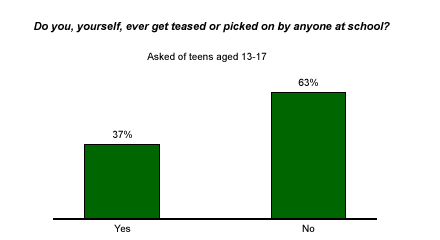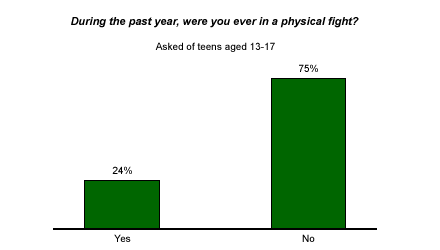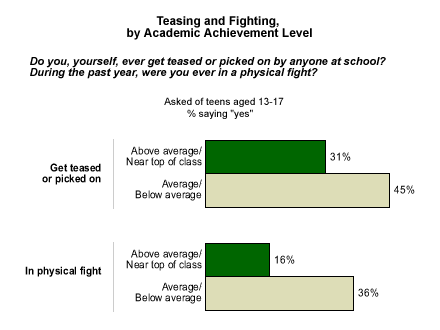A generation ago, when the parents of today's teens were kids, bullying tended to be something that adults left to kids to work out for themselves. After all, it was generally considered that victims of bullying could do no worse in their schoolyards than fight back with their fists. But today, those same schoolyards seem more dangerous. As the deaths at Columbine High School in 1999 tragically demonstrated, some bullying victims now fight back with guns and bombs.
Bullying has always been a terrible experience for those being bullied, but the deadly school violence of the past several years has forced consideration of broader consequences. And according to the most recent Gallup Youth Survey of teens aged 13 to 17*, bullying is quite widespread. More than a third (37%) of teens admit that they are sometimes teased or picked on at school, and boys are slightly more likely than girls to say this happens to them.
Not all fights at school take place between bullies and their victims, though in past surveys teens have offered "standing up for oneself" as a top reason why they get into fights. Regardless of the reason, nearly a quarter (24%) of teens said they have been in a physical fight in the past year. And fighting is not reserved solely for boys -- while 30% of boys admit to fighting in the past year, nearly one in five girls (18%) also said they had been in a physical fight.


Stan Davis, a social worker and author of the book, Schools Where Everyone Belongs: Practical Strategies for Reducing Bullying, is not surprised by the seemingly high number of teens who admit to fighting. In Davis' opinion, "Kids are increasingly being presented [with] a media culture in which physical responses to frustration are the role of heroes, and most kids get little education in any other methods of resolving conflicts."
Gallup's data also suggest a relationship between getting teased or picked on at school and getting into physical fights. Thirty-one percent of teens who said they get teased or picked on at school also said they have been in a fight in the past year, compared with 20% of teens who don't get teased.
High-Achieving Students Less Likely to Be Bullied
Students who define their class standing as "above average" are less likely to be teased and picked on, and less likely to get into fights, than students with average class standing or below. Thirty-one percent of teens who say that they are "above average" or "near the top" of their class admit to getting teased or picked on, compared with 45% of teens who define their class standing as "average" or "below average." Just 16% of above-average kids said they've been in a fight in the past year, as did 36% of average or below-average kids.

Davis speculates that "the more highly achieving students might have more social status in the school, more ability to deflect teasing through verbal responses, or might be kids who have more resources in their environments so the same teasing does not bother them." He also says that teens who perform above average academically are likely to be in honors or AP classes, where there are fewer behavioral problems.
Bottom Line
According to a March 2001 Gallup Poll, 62% of U.S. adults said that "bullying and teasing of students at school" was an "extremely" or "very" important cause of school shootings. Research suggests that parents, teachers, and other kids can make a difference in preventing bullying. Davis, who conducts bullying prevention workshops for schools around the country, says that teachers can discourage bullying by establishing "clear behavior expectations and a system of consequences . . . for physical and verbal aggression" and "through use of praise, positive staff-student relationships . . . and helping bystanders stand up to bullies, befriend targets, and work with adults to stop this problem."
*The Gallup Youth Survey is conducted via an Internet methodology provided by Knowledge Networks, using an online research panel that is designed to be representative of the entire U.S. population. The current questionnaire was completed by 517 respondents, aged 13 to 17, between Aug. 1 and Aug. 29, 2003. For results based on the total sample, one can say with 95% confidence that the maximum margin of sampling error is ±5 percentage points.